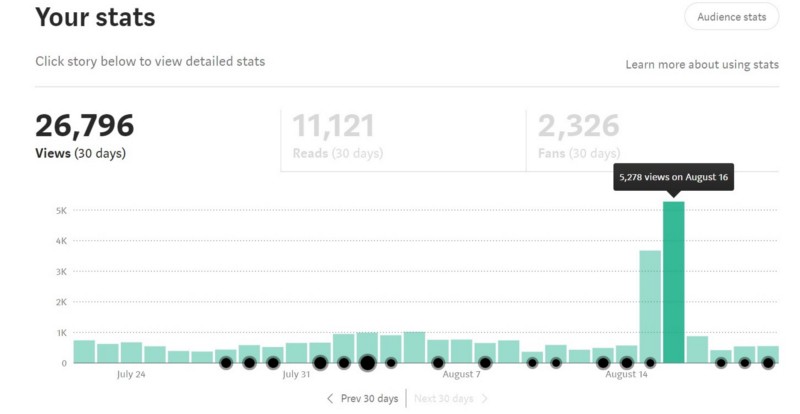Is Medium dying or growing? Let’s take a look.

Many writers here seem to be overly fascinated with what’s going on with the Medium platform. Some read about one well-known writer leaving and start shouting from the rooftops that Medium is dead. Others see their views drop and assume that means the best days are over for the platform.
What’s the truth?
The reality is that it’s very difficult to tell because Medium doesn’t publicly release much data. But we can still look elsewhere and try to piece together what’s happening.
How many subscribers does Medium have?
Every time someone subscribes to Medium their account will be set to automatically follow the Medium Staff account. That account currently shows that it has 64 million followers. Source: Medium Staff account.

Of course, you can unfollow this account, and maybe some have done so. But we still have a good idea of the number of subscribers.
An article from October 21, shows that they had 54 million subscribers. This means that Medium has gained 10 million subscribers in the last 10 months.
Millions are likely subscribed but no longer visit the site. Only Medium will have this data.
How many paying subscribers does Medium have?
The article mentioned above says that there are 700,000 paying members as of quarter 4, 2020. That’s an increase from 400,000 in 2019.
I know that those figures are now around a year and a half out of date, but it’s the best estimate I can find.
Both the number of general members and paying members appear to be increasing, not decreasing.
How many readers visit the Medium website every month?
For these figures, I headed over to Similar Web. Their latest figures (which are estimates) show that Medium had the following visitor numbers over the last 3 months:
May — 148.5 million
June — 138.7 million
July — 136.1 million
Visitor numbers have fallen during the last two months, but that could just be because it’s summer.
The Blogging Guide reports that over the 6 months from March to August last year, the average monthly visitors was 182 million, with the high point being March, which had 234.5 million visitors.
How many pages does each visitor read?
According to Similar web, during the last 3 months, the average visitor looked at 2.03 pages and spent an average of 1 minute and 56 seconds on the site.
That means that during July, just over 276 million pages were visited.
How does Medium compare to other websites?
Similar Web currently ranks Medium as number 401 globally. That has dropped from number 384 in the last 3 months.
The Blogging Guide mentions that Alexa.com ranked it at number 147 last year.
Different ranking methods are likely used, but it seems like Medium is currently less popular than last year when compared with other sites.
What country do readers come from?
Similar Web shows the following country rankings:
USA 26.43%
India 7.37%
UK 3.81%
Canada 3.16%
Brazil 2.96%
Others 56.27%
What are the demographics of Medium readers?
The following data is also from Similar Web.
65.34% of site visitors are male, while 34.66% are female.
The age distribution is as follows:
18–24 years old — 24.8%
25–34 years old — 35.47%
35–44 years old — 18.96%
45–54 years old — 10.65%
55–64 years old — 6.39%
65 years and older — 3.73%
Over 60% of readers are under 35 years old.
How many writers are there on Medium?
According to the Blogging Guide website, 200,000 writers have joined since 2017. I don’t have any up-to-date figures. I also have no idea how many active writers there are.
How much are writers paid?
According to the Blogging Guide website, Medium had paid out $28 million to writers between 2017 and 2020. The best year was 2020 when $11 million was paid out.
They also mention that around 70% of writers are thought to earn money on the platform, with only 5–6% earning over $100 per month.
How much revenue does Medium earn?
Owler.com shows Medium’s annual revenue at $25–100 million.
Based on 700,000 subscribers paying $50 a year, the revenue would be around $35 million.
Is Medium dying?
Based on all the above information, my take on it is that Medium is not dying at all. I’d say it’s quite the opposite.
I still think it’s the best platform for new writers and more experienced writers.
If you have some patience and are consistent with your writing, it seems fairly easy to make money on Medium.



















